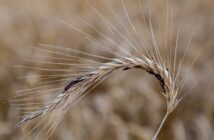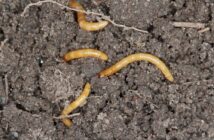With the rise in nitrogen prices continuing unabated, recent trial results from ADAS have found that when Revystar® XE (Xemium® + Revysol®) was included in winter wheat fungicide programmes there was an uplift in yield, even where the application of nitrogen was cut back.
Speaking in the second of BASF’s series of spring Funginars, Dr Julie Smith senior plant pathology researcher ADAS, who led the work said, “If you are going to reduce your nitrogen this year don’t be tempted to be too light with the fungicide programmes because Revystar® XE can increase yield at commercial nitrogen rates compared with competitors, or, if growers decide to reduce the rate of nitrogen then it can maintain yield.”
The independent trials in 2021 looked at the interaction of nitrogen and fungicides, with Gravity, which has a Recommended List (RL) rating of 4.7 for Septoria and Graham with a RL rating of 6.7.
Dr Smith said, “We applied 5 different nitrogen rates ranging from 37 kgN/ha up to 370 kgN/ha at the same timings as on the commercial crop and three different fungicide treatments, untreated, Revystar® XE and Ascra® Xpro with applications solely at T2.
Measurements of the Healthy Area Duration (HAD), a combined measure of healthy canopy size and duration showed the more resistant variety, Graham, had higher HAD values than the Gravity across the board.
“There were responses to nitrogen of course, but on top of the nitrogen responses Revystar® XE gave increases in HAD and yield above the untreated and above the Ascra® Xpro. The HAD values and yield were generally lower for Gravity compared with Graham but whether you are sowing a susceptible or a resistant variety you get the benefits from the nitrogen and Revystar® XE interactions.”
In the UK, winter wheat is considered to be a source limited crop, a crop which doesn’t have enough green leaf area to fulfil its yield capacity. Dr Smith said, “If we can do something to increase or maintain that green area for a bit longer then we can generally push up yield.”
Ensuring programmes work to their optimum is therefore essential
Ensuring fungicide programmes work to their optimum is therefore essential. Dr Jon Helliwell, BASF, business development manager for Cereal Fungicides, said, “The impact of maintaining a healthy canopy is immense on yield and the bottom line and the fungicide programme is key to this.”
In order to understand how different active ingredients are performing and also how effectively they can protect other partner fungicides, BASF collect and monitor Septoria isolates from across the UK each year, to gauge how the population is evolving.
“The performance of the isopropanol- azole Revysol® is unchanged over the last 4 years for the UK range of Septoria isolates. Revysol®’s sensitivity has remained absolutely rock solid with no movement in the dose required to inhibit 50% of the population (ED50) and importantly, results from field performance trials remain very strong,” said Dr Helliwell.
In 2021, independent data from the AHDB illustrated just how effective Revysol® is against Septoria. “ A full dose of Revysol® gave ~80% control of Septoria, compared to ~20% for prothioconazole.
Resistance monitoring has shown there is an ongoing further shift in prothioconazole-desthio sensitivity. This metabolite of prothioconazole showed a further increased median ED50 in 2021 coupled with a reduction in field performance. This shift in conventional azole efficacy has important implications for the foundation of fungicide programmes. The strongest azole, Revysol®, should be utilised both to maintain the strongest levels of disease control, whilst protecting at risk modes of action partnered with it. It’s clear that innovation chemistry- stronger chemistry, like Revystar® XE, is now the only way to adequately control Septoria in the absence of CTL,” he said
AHDB disease monitoring work between 2017-2019 at T2 showed a gradual decline in performance of conventional fungicides. In 2020,the first year that Revystar® XE was launched there was a clear differentiation between Revystar® XE and conventional products in Ascra® Xpro.
Last season at the T1 timing Revystar® XE gave significant benefits in yield and margin over Ascra® Xpro, where at the time there was a perception of low disease pressure, as leaf 3 was visually green due to the very cool and dry conditions. 38 replicated T1 product comparisons between 0.75 l/ha Revystar® XE (Xemium® + Revysol®) and 1 l/ha Ascra® Xpro (bixafen + fluopyram) gave on average a 0.24 t/ha benefit from switching up to Revystar® XE. At last year’s wheat price of £185 t/ha that equated to £42 /ha benefit from Revystar® XE.




